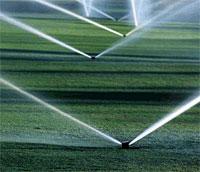Get used to it; evolving legislation regarding water use is the new reality for superintendents in many parts of the country, and on the horizon for everyone else.
A revised version of water withdrawal regulations goes into effect in New York on April 1, according to the state's Department of Environmental Conservation. The purpose of these regulations is to implement a permitting, registration and reporting program for water withdrawals equaling or exceeding a threshold volume of 100,000 gallons per day. They also implement New York's commitments under the Great Lakes-St. Lawrence River Basin Water Resources Compact.
 For existing water withdrawal systems that are not exempt and that were above the threshold as of February 15, 2012, an initial permit process is provided which is less costly and time consuming than the standard permit process and provides additional time to comply depending on the capacity of the water withdrawal system. To take advantage of the initial permit process, existing withdrawals must have been reported by February 15, 2012.
For existing water withdrawal systems that are not exempt and that were above the threshold as of February 15, 2012, an initial permit process is provided which is less costly and time consuming than the standard permit process and provides additional time to comply depending on the capacity of the water withdrawal system. To take advantage of the initial permit process, existing withdrawals must have been reported by February 15, 2012.
Here are some highlights of the new regulations as provided by the New York State Turfgrass Association:
> Annual reports for 2012 should be submitted by March 31, 2013. In subsequent years the reporting date will be March 31.
> Threshold before regulations kick in remains at the ability to withdraw 100,000 gallons per day.
> A $50 reporting fee is in effect until December 31, 2013; after that no fee is required.
> Most permits will have a 10-year term, however shorter time frames can be used at DEC's discretion. In addition, DEC's review of annual reports may identify scenarios that may trigger the need for a permit modification or indicate possible permit violations. One scenario is systems that are approaching their permitted withdrawal limits.
> As for water conservation measures, future annual reports will include an update on the progress and effectiveness of your water conservation measures. A manual and form for water conservation measures will be available on the DEC Web site.
> Long Island wells are exempt from reporting requirements as well as additional permitting; they have pre-existing regulations.
> Exempt from permitting are withdrawals that have received approval from the Delaware River Basin Commission or Susquehanna River Basin Commission but usage reporting is required.
> Under Section 601.6 of the regulations, there are 11 actions which can no longer be taken without first having obtained a withdrawal permit. These actions include such things as changing the pumping specifications or increasing storage capacity
> Facilities that reported water withdrawals by February 15, 2012 can apply for an initial permit. The schedule for obtaining an initial permit is:
June 1, 2013 - ability to withdraw 100 million gallons/day (mgd) or more
February 15, 2014 - greater than 10 mgd but less than 100 mgd
February 15, 2015 - greater than 2 mgd but less than 10 mgd
February 15, 2016 - greater than 0.5 mgd but less than 2 mgd
February 15, 2017 - greater than 0.1 mgd but less than 0.5 mgd
> Those facilities who did not report by February 15, 2012 need to get permitted by June 1, 2013 no matter what their numbers are. In these cases a complete permit application will be required which I tend to believe will be more involved than in applying for the "initial" permit. As soon as possible, facilities with this issue should contact Richard Kruzansky (518-402-8182) at the DEC Division of Water for help bringing a facility into compliance.
> All pumping facilities will need totalizing flow meters which will need to be calibrated within the year prior to a permit application and calibrated at least once every 5 year thereafter.
> Any well installed after April 1, 2013 will need equipment to measure and record water levels; calibration of this equipment every 5 years.
> Ponds installed after April 1, 2013 need equipment to measure water levels and storage volumes.
> There are record keeping and inspection requirements.

